Catocala ilia
Catocala ilia
kah-TOCK-uh-lahmILL-ee-uh
(Cramer, 1776)
Phalaena ilia
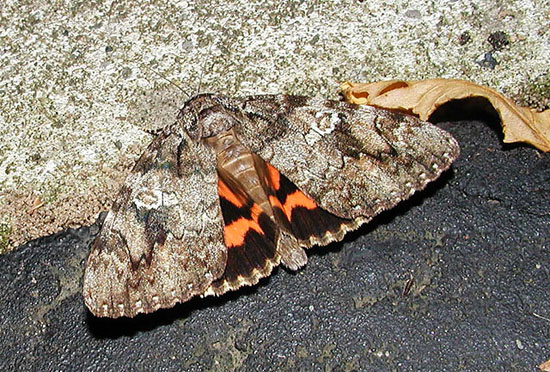
Catocala ilia from Michigan, courtesy of Cindy Mead.
This site has been created by
Bill Oehlke at oehlkew@islandtelecom.com
Comments, suggestions and/or additional information are welcomed by Bill.
| TAXONOMY:
Superfamily: Noctuoidea
Family: Erebidae, Leach, [1815]
Subfamily: Erebinae, Leach, [1815]
Tribe: Catocalini, Boisduval, [1828]
Genus: Catocala, Schrank, 1802
|
DISTRIBUTION: Catocala ilia,
the Ilia Underwing (also known as the Beloved Underwing or the Wife)
(wingspan: 65-82mm), flies from
Newfoundland and
Nova Scotia to at least
Saskatchewan in
Canada.
There are records for New Brunswick, Quebec,
Ontario (TD/MB), Manitoba and British Columbia, but the BC indication needs verification.
I have not seen them yet on Prince Edward Island.
In the United States this species ranges through New Hampshire (DL),
(Connecticut) through
New Jersey (JG) and Tennessee (TP) south to
Florida, west to
Texas,
and Oklahoma and north through
Missouri, and
South Dakota,
to Minnesota,
and Michigan (CM/HDK). The Lep. Soc. season summary reports a
specimen in Placer County,
California.
It has also been reported in
Alabama (DB),
Arizona,
Arkansas,
Colorado,
Delaware,
District of Columbia,
Georgia (AS),
Idaho,
Illinois (BG),
Indiana,
Iowa,
Kansas,
Kentucky,
Louisiana (VB),
Maine (MDA),
Maryland,
Massachusetts,
Mississippi,
Nebraska,
New Mexico,
New York (SD),
North Carolina,
North Dakota,
Ohio,
Oregon,
Pennsylvania,
Rhode Island,
South Carolina,
Utah,
Vermont,
Virginia,
West Virginia,
Wisconsin (GL) and
Wyoming.
There is considerable variation in forewing patterning.
In the form conspicua, the reniform spot is white against a dark
background. Conspicua
below in James K. Adams image. Note the cream fringe and deeply scalloped
outer margin. |
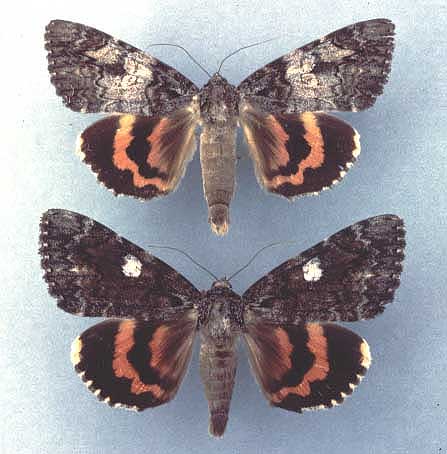 |
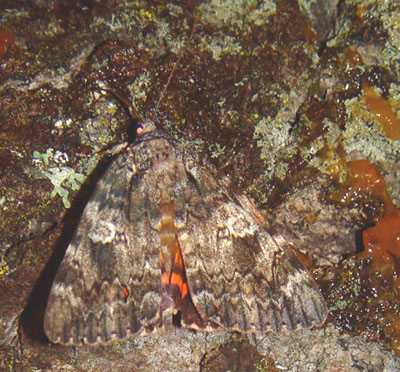 |
The ability of this moth to blend in with its background
is very apparent in this Tim Dyson copyright
image (August 31, 2004, Peterborough, Ontario) to the left.
Other form names, previously assigned, include "confusa" where the
forewing is an even grey-brown
blend, "umbrosa" where there is no white in or around the reniform
spot, "normani", a semi-melanic form, dark from base to postmedial line and
"satanas", a melanic form with an entirely black forewing.
"Normani" and "satanas" also tend to have wider black bands
(in some cases breaking the red band)
in the lower wings. |
See an extremely rare form at
Catocala ilia
The form names, above, including "umbrosa" Worthington
are invalid in accordance with the ICZN (international code of
zoological nomenclature) (forms hold no official status as a species).
Umbrosa was subsequently found to be a
distinct species from ilia, and Brou 2002 reapplied the
name umbrosa, not as a form, but a newly described species.
It is still nice to differentiate those moths within the species
that have consistent distinct characters even if they do come from
the same female who may be of a different "form" from her offspring.
| 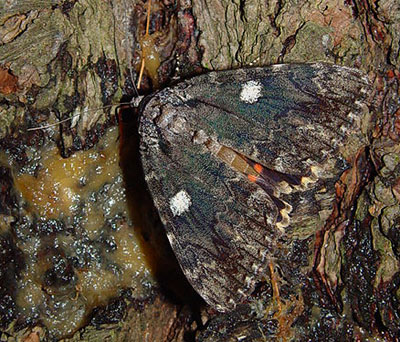 |
Catocala ilia "form" conspicua (right, above), July 28,
Peterborough, Ontario, courtesy of Tim Dyson.
The following evening Tim encountered the much darker form below,
lacking white in or around the reniform spot. Larry Gall has confirmed
it as form "satanas".
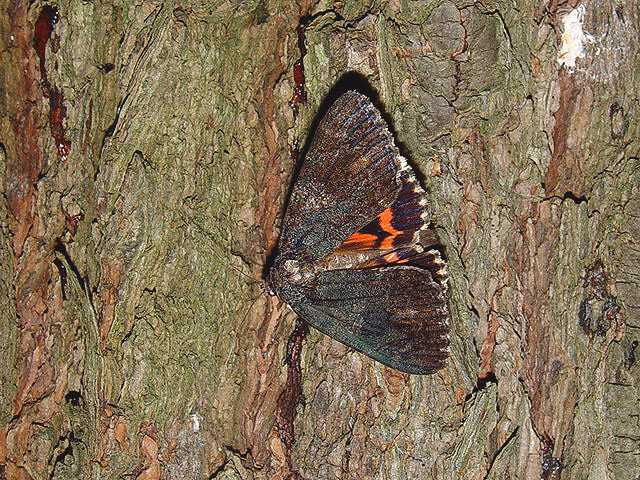
Catocala ilia "satanas", courtesy of Tim Dyson, id confirmed
by Larry Gall.
Tim Dyson has an extensive bait trail which he inspects
on a regular basis. He has encountered many of the lesser known forms.
On July 26-27, 2006, Tim was able to get this shot of Catocala ilia
"normani" from Peterborough, Ontario.
This semi-melanic form has been confirmed as "normani" by Larry Gall.
The forewings are not quite as dark as in "satanas", and the reniform spot
is outlined in white. |
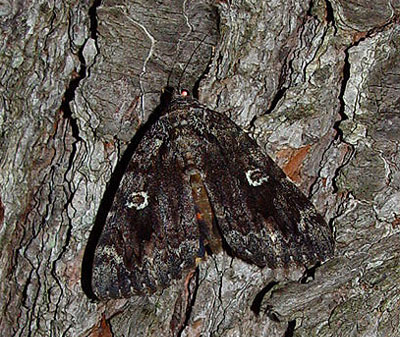 |
Visit Catocala ilia, form conspicua, Eddie Jones Park, Caddo Parish, Louisiana, May 9, 2012, courtesy of Jeff Trahan.
Visit Catocala ilia larva, Rumney, Grafton County, New Hampshire, June 1, courtesy of Deb Lievens.
Visit Catocala ilia larva, Calais, Washington County, Vermont, July 7, 2011, courtesy of Alyssa Evans, via Bill Evans.
Visit Catocala ilia Pickens County, Georgia, July 14, 2009, Aubrey Scott.
Visit Catocala ilia, Annapolis, Anne Arundel County, Maryland, July 16, 2010, courtesy of Saundra Byrd.
Visit Catocala ilia form "normani", female, bait trail, 82mm, July 17, 1994, Mason, Ingham County, Michigan,
courtesy of Harry King.
Visit Catocala ilia form "satanas", Lake Huron, Huron County, Michigan, July 19, 2015,
courtesy of Betsy Higgins.
Visit Catocala ilia, open subreniform spot, Peterborough, Ontario, July 19, 2016, courtesy of Tim Dyson.
Visit Catocala ilia, form conspicua, courtesy of Reinhart Roehrig.
Visit Catocala ilia, Lancaster, Coos County, New Hampshire, August 15, 2014, Ron White.
Visit Catocala ilia, series of forms, Peterborough, Ontario, July-August 25, 2016, courtesy of Tim Dyson.
Visit Catocala ilia form satanas, Athol, Worcester Co., Massachusetts, Sept. 1, 2011, Dave Small.
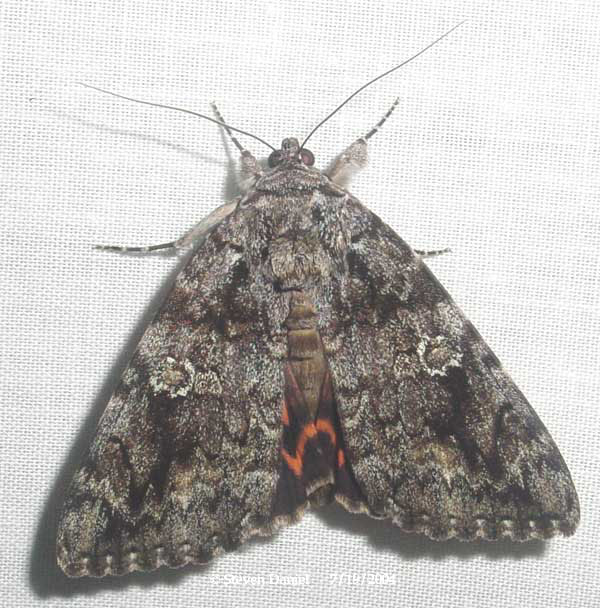
Catocala ilia, Monroe County, New York, July 19, 2004,
courtesy of Steve Daniel copyright.
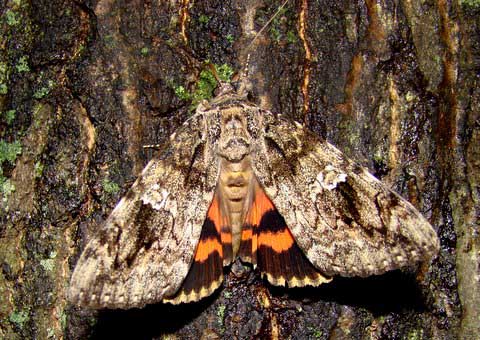
|
I particularly enjoy the "face" on the thorax of the C. ilia (left) from Windsor, Ontario,
courtesy of Maurice Bottos.
The diffuse double antemedian line, surrounding a creamy-grey central area, is accentuated by dark scaling.
There is a black dash in the median area, cutting through the midpoint of the am line and extending
briefly into the median area.
The reniform spot is inwardly yellowish, outlined in grey and then surrounded by white. The subreniform spot is
visible (yellowish grey) in the typical form. I would describe it as closed, but it is connected to the
pm line by an elongated "tail".
The three upper teeth of the pm line have black tips, This feature, combined with the dark patch along
the outside of the reniform spot up to the costa, and a slightly darker upper tooth on the subterminal line
suggest a faint dark arc.
The subterminal line is distinct, inwardly bordered by white, especially toward the innner margin.
An additional toothed grey line separates the brownish grey scaling from the whitish scaling in the
subterminal area.
|
There is dark scaling along the hindwing inner margin, particularly in the basal area.
There is some bleeding of the salmony orange colouration of the hindwing, becoming pale yellow-orange
in the outer margin. Whitish fringe is heavily checked with black.
Visit Catocala ilia, Windsor, Ontario, courtesy of
Maurice Bottos.
Visit Catocala ilia, southern Montgomery County, Tennessee,
courtesy of Tom Payne.
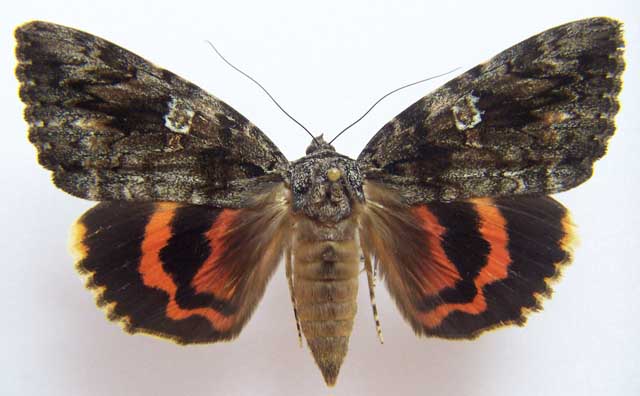
Catocala ilia, Mason, Ingham County, Michigan,
80mm, bait, July 11, 1994, courtesy of Harry King.
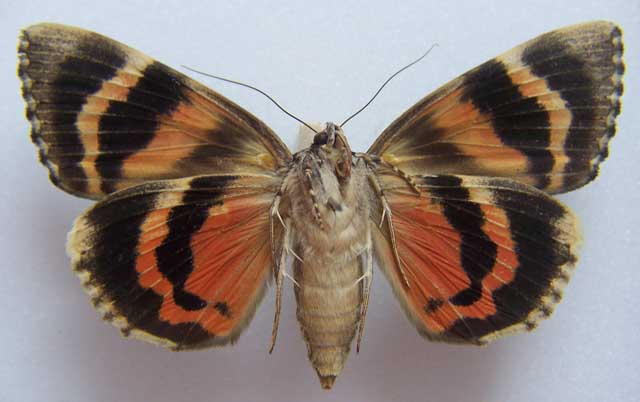
Catocala ilia (verso), Mason, Ingham County, Michigan,
80mm, bait, July 11, 1994, courtesy of Harry King.
FLIGHT TIMES AND PREFERRED FOOD PLANTS:
Catocala ilia are usually on the wing from June to
September.
Ian Miller reports specimens taken in Eau Claire County, Wisconsin, on July 29 and August 18, 2011.
The Catocala ilia caterpillar feeds on black, burr, red and white oaks.
ECLOSION:Adults eclose from pupae at soil surface.
SCENTING AND MATING:Catocala ilia females
emit an airbourne pheromone and males use their antennae to track the
scent plume. Catocala ilia August 1, 2005, Peterborough, Ontario,
courtesy of Tim Dyson. copyright |
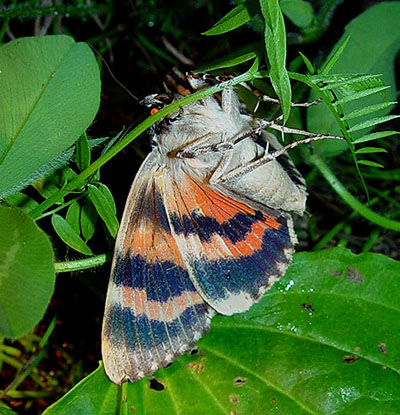 |
EGGS, CATERPILLARS, COCOONS, AND PUPAE:
Eggs are deposited on
tree bark in the fall and hatch the following spring.
Ron Nelson, teamed with Gabriel Larrabee, sent me the image
below of Catocala ilia
eggs from Milwaukee.
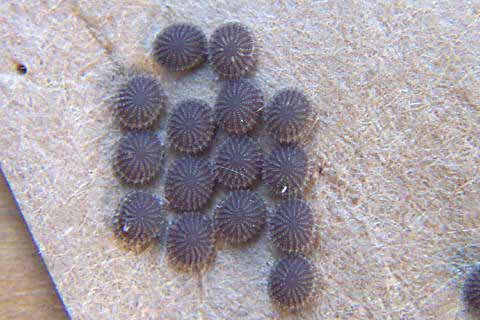
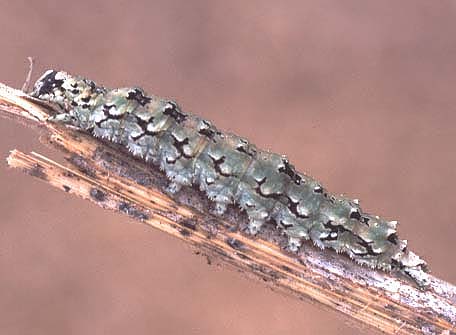
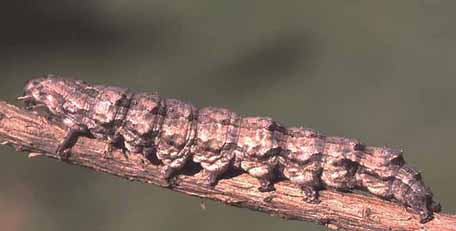
Penultimate instar top and final instar courtesy of James K. Adams.
Ron Nelson, teamed with Gabriel Larrabee, sent me the images
below of Catocala ilia
pupae from Milwaukee.
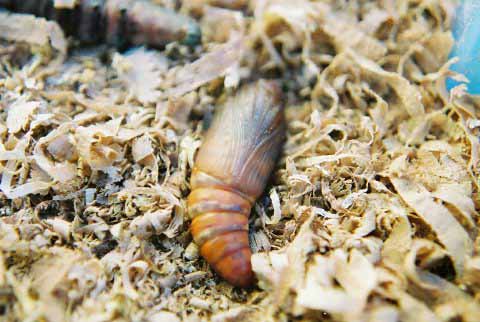
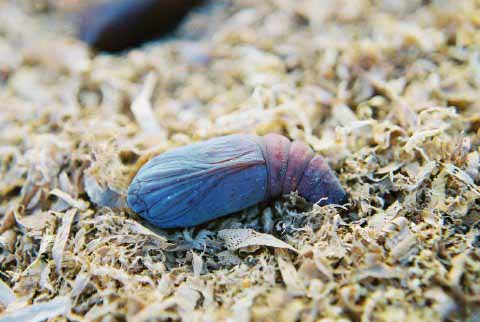
Larval Food Plants
Listed below are primary food plant(s) and alternate food plants.
It is hoped that this alphabetical listing followed by the common
name of the foodplant will prove useful. The list is not exhaustive,
although some species seem very host specific.
Experimenting with closely related foodplants is worthwhile.
Quercus alba
Quercus macrocarpa.......
Quercus rubra
Quercus velutina
|
White oak
Burr oak
Northern red oak
Black oak
|
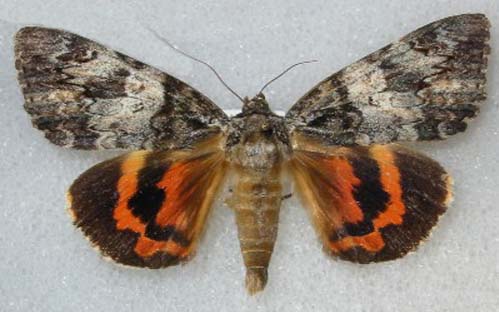
Catocala ilia courtesy of
Jessse Donavan, New Jersey.
Use your browser "Back" button to return to the previous page.
Return to Main Index
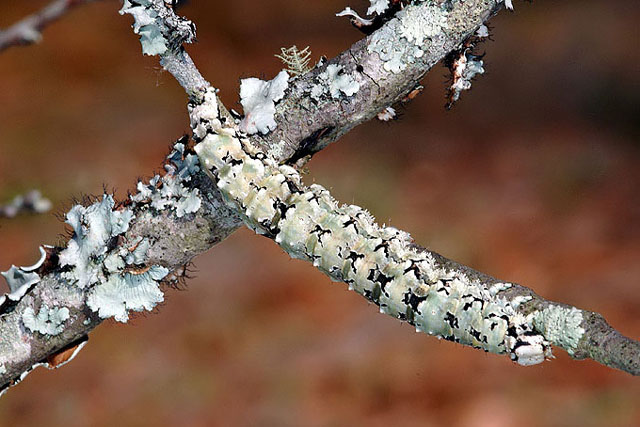
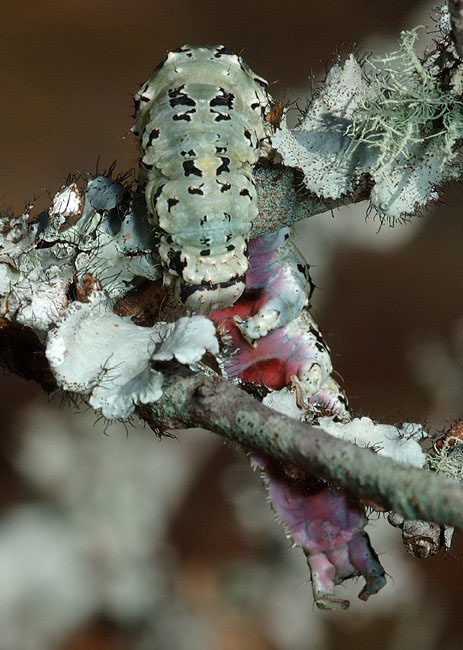
Catocala ilia, March 25, Jasper, South Carolina, courtesy
of Dr. Wasil Khan.
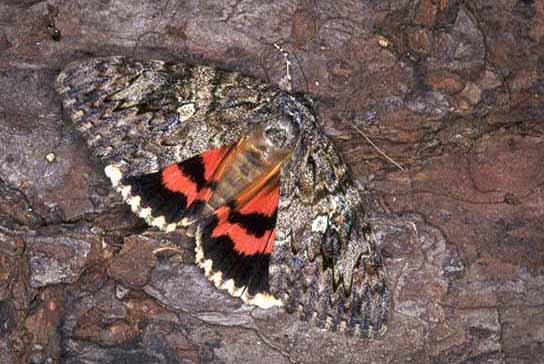
Catocala ilia,
Marion County, Florida, courtesy of Leroy Simon, id by Vernon Brou.
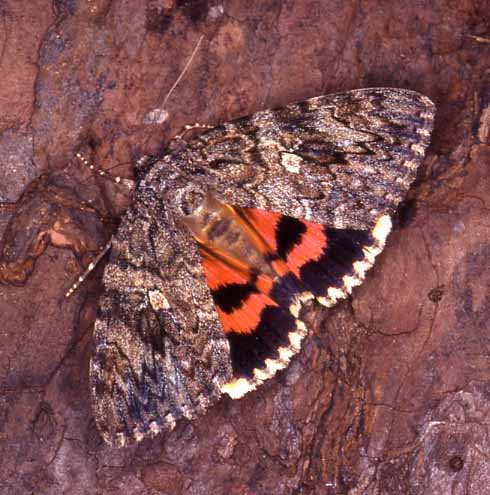
Catocala ilia,
Marion County, Florida, courtesy of Leroy Simon, id by Vernon Brou.
Return to Canadian Catocala Index
Return to Main Catocala Index
This page is brought to you by Bill Oehlke and the
WLSS. Pages are on space rented from Bizland. If you would like to become a "Patron of the Sphingidae or Catocala Sites", contact Bill.
Please send sightings/images to Bill. I will do my best to respond to requests for identification help.
Enjoy one of nature's wonderments: Live Saturniidae (Giant Silkmoth) cocoons.
 | 
To show appreciation for this site, click on the flashing
butterfly to the left, a link to many worldwide insect sites.
|
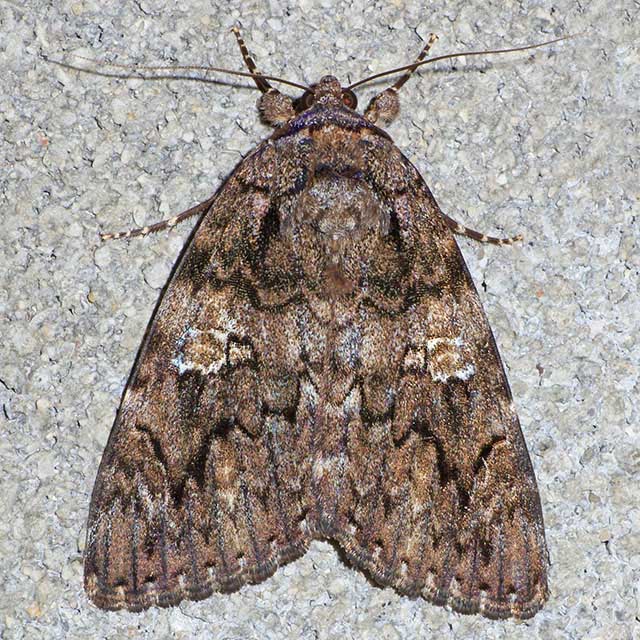
Catocala ilia, Val Verde County, Texas,
courtesy of Dave Barker.
Ian Miller writes, "My catocala egg obtaining technique is a matter of conditioning females prior to their peak egg deposition. I have been
working with several females of various species including relicta which are by far the easiest Catocala to obtain eggs from.
"Catocala ilia are placed in a paper bag for 2 -3 nights with no food. Adults are removed to outdoor screened cages in the morning and sprayed heavily with
water three times and then placed back in the bags at dusk. On the 4th night I introduce my bait mixture on a container lid at the bottom of an inflated grocery
bag.
"I take two pieces of burr oak bark and wire it onto both sides of the bag and the females will dump just about all their eggs the 4th night."























